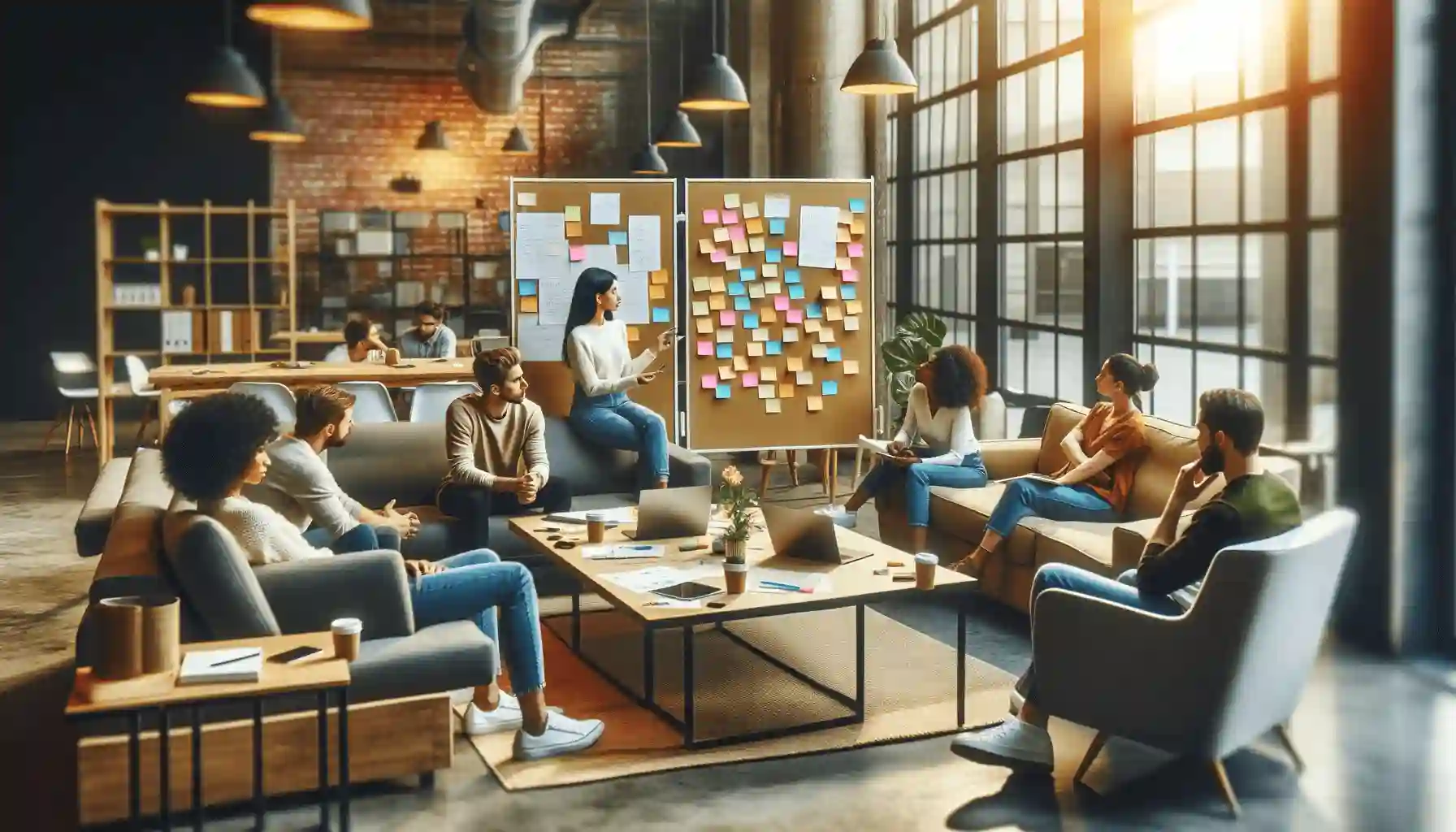Handover Meeting
This guide will walk you through the essential elements of use handover meeting to keep your attendees aligned and engaged.
Try Lark for Free
Hosting a successful handover meeting is crucial for organizations to ensure seamless transitions and maintain operational efficiency. Whether it involves passing the baton from one team to another or transitioning responsibilities from one individual to another within the same team, an effective handover meeting lays the foundation for continuity and success. This comprehensive guide provides actionable insights, best practices, and practical examples for conducting productive handover meetings, enabling you to navigate this critical phase with confidence and strategic finesse.
Use Lark Meetings to turn meetings into true collaborative experiences.
What is a handover meeting?
A handover meeting, often referred to as a transition or turnover meeting, is a dedicated session where the transfer of responsibilities, information, and decision-making authority from one party to another takes place. It serves as a formal step to ensure a comprehensive and transparent transfer of duties, knowledge, and tasks. This meeting is crucial in embracing continuity, minimizing disruptions, and promoting an organized approach to changes within an organization.
Goals of handover meeting
The primary goals of a handover meeting are to facilitate a smooth and effective transfer of responsibilities, ensure a thorough understanding of the new roles and expectations, and establish clear lines of communication and support. Additionally, the meeting aims to:
- Identify potential challenges and risks during the transition.
- Create a platform for the outgoing and incoming parties to address queries and concerns.
- Align expectations and ensure clarity regarding deliverables and timelines.
Who should attend handover meetings?
Key stakeholders involved in handover processes should be a part of the handover meeting. These stakeholders may include:
- Outgoing and incoming team leaders or managers
- Key team members directly impacted by the handover
- Relevant personnel from support functions such as HR, finance, or operations
Including the right mix of individuals ensures comprehensive insights, effective communication, and streamlined coordination during the transition phase.
Learn more about Lark x Meetings
Topics, agenda, and structure of handover meeting
The agenda for a handover meeting typically includes the following key components:
-
Introductions and Context Setting:
- Overview of the current state and the need for the handover.
-
Transfer of Responsibilities and Tasks:
- Detailed review and discussion of the specific roles, duties, and tasks being handed over.
-
Information Sharing:
- Transfer of knowledge, critical information, and best practices related to the roles and responsibilities.
-
Expectations and Support:
- Alignment on expectations, resource needs, and ongoing support.
-
Q&A and Open Discussions:
- Dedicated time for clarifications and open dialogue to address any uncertainties.
The structure should allow for an interactive and collaborative environment, promoting active participation and exchange of critical information.
Related:
Master the Art of Meeting Notes with Lark for Enhanced Collaboration | Lark Blog | Lark BlogLearn more about Lark x Meetings
How often does a handover meeting occur?
Handover meetings typically occur during various organizational events or transitions, including:
- Leadership changes or succession planning
- Project handovers within cross-functional teams
- Employee transitions due to promotions, resignations, or role changes
- Knowledge transfer between outgoing and incoming team members
The frequency of handover meetings varies based on the specific context and the nature of the transition, ensuring that critical details and responsibilities are seamlessly transferred.
Key differences between handover meeting and another similar meeting
Handover Meeting vs. Project Kick-off Meeting
| Handover Meeting | Project Kick-off Meeting |
|---|---|
| Focuses on transition and knowledge transfer | Centers around project initiation and planning |
| Involves outgoing and incoming personnel | Involves project stakeholders, including sponsors and team members |
| Emphasizes historical context and lessons learned | Emphasizes future project scope, objectives, and deliverables |
| Aims to ensure continuity and operational stability | Aims to align stakeholders, establish project vision, and set milestones |
Learn more about Lark x Meetings
Three practical examples of handover meetings
Example 1: leadership transition in a corporate setting
Example 1: leadership transition in a corporate setting
In a multinational corporation, a C-level executive transitions out of the organization, necessitating a comprehensive handover meeting with the incoming executive, board members, and key department heads. The meeting focuses on aligning strategic objectives, critical priorities, and establishing a seamless transition plan ensuring minimal disruption to ongoing initiatives.
Example 2: knowledge transfer within a project team
Example 2: knowledge transfer within a project team
In a software development project, a senior developer assumes a new role, requiring a detailed handover meeting with the incoming team member. The session encompasses a thorough review of ongoing tasks, code repositories, and client expectations, emphasizing a smooth transfer of technical knowledge and domain-specific insights.
Example 3: employee role transition in a small business
Example 3: employee role transition in a small business
A team leader in a small manufacturing enterprise prepares to transition roles, necessitating a handover meeting to ensure a seamless transfer of responsibilities and client management. The meeting includes active involvement of the outgoing and incoming leaders, emphasizing clear client communication, task allocation, and resource requirements to maintain operational continuity.
Common pitfalls of handover meetings
Effective handover meetings require careful planning and execution to avoid common pitfalls such as:
- Lack of clear agenda and structure
- Insufficient time allocation for crucial discussions
- Inadequate participation and engagement from key stakeholders
- Incomplete or unclear documentation of the transfer
- Assumption of knowledge without comprehensive information sharing
Mitigating these pitfalls is essential to ensure the success of the handover process.
Learn more about Lark x Meetings
Dos and don'ts of handover meetings
| Do's | Don'ts |
|---|---|
| Communicate the meeting agenda in advance | Procrastinate on initiating the handover process |
| Encourage active participation and open dialogue | Ignore the inclusion of critical stakeholders in the meeting |
| Document and distribute comprehensive meeting summaries | Rely solely on verbal communication for critical information |
| Ensure clear responsibilities and actionable outcomes | Overlook the importance of ongoing support and follow-up |
| Establish proactive solutions for potential challenges | Disregard the historical context and lessons learned |
What makes a virtual handover meeting successful?
A successful virtual handover meeting relies on robust communication platforms, clear documentation, and proactive engagement. Leveraging video conferencing tools, collaborative project management systems, and secure information sharing platforms can enhance the virtual handover experience. An effective facilitator, clear agendas, and supportive digital resources are essential for realizing the objectives of a virtual handover meeting.
Learn more about Lark x Meetings
Typical takeaways of the handover meeting
At the conclusion of a successful handover meeting, the key takeaways include:
- Clear understanding of roles, responsibilities, and expectations
- Defined action items and timelines for the transition process
- Comprehensive knowledge transfer and information sharing
- Established communication channels and ongoing support mechanisms
- Consensus on next steps and continued collaboration
Questions to ask in the handover meeting
For the Outgoing Party
- What are the critical aspects that require immediate attention by the incoming party?
- Are there any pending or ongoing tasks that need to be addressed post-transition?
- What are the potential challenges or roadblocks that the incoming party should be aware of?
- How can ongoing support be provided to ensure a smooth transition?
For the Incoming Party
- What are the key expectations and deliverables from the outgoing party?
- How can the historical context and institutional knowledge be effectively transferred?
- Are there specific resources or support required to seamlessly assume the new responsibilities?
- What are the immediate action items and key focus areas after the handover?
Learn more about Lark x Meetings
Conclusion
Effectively conducting a handover meeting is essential for successful transitions and sustained operational excellence within organizations. By understanding the critical aspects, preparing diligently, and leveraging best practices, organizations can ensure seamless handovers, empowering teams and individuals to navigate transitions with confidence and clarity.
Use Lark Meetings to turn meetings into true collaborative experiences.
A Game Changer for Handover Meeting: Empower your team with Lark Meetings
In the fast-paced and dynamic world of modern business, effective communication and collaboration are crucial for success of Handover Meeting. Here we introduce Lark Meetings to serve as a centralized hub for all communication needs.
Transform your meetings into collaborative endeavors

Leverage the potency of in-call document sharing, intelligent meeting minutes, and mobile-optimized features to enhance productivity collaboratively, irrespective of your location or schedule.
Seamlessly collaborate in real-time, across any device

Share live documents instead of just screen views. Participants can navigate and edit simultaneously within the video call window, even while on the move.
Shift your focus to engagement, not note-taking

Lark Minutes automatically converts video meetings into transcripts, facilitating easy viewing, searching, and collaborative editing. Stay in the loop asynchronously, even if you can't attend the live meeting. Lark Minutes for meeting minutes support translation into 10+ different languages.
Break language barriers in communication

Lark Meetings provide real-time translation for subtitles, allowing individuals from diverse backgrounds to express themselves in their native languages. Ensure every voice is heard, regardless of geographical location. Live subtitles currently support translations from English, Chinese, and Japanese to 10+ different languages. See more translation feature in Lark.
Connect with larger audiences
Host dynamic online meetings and events accommodating up to 1,000 participants, with the flexibility of up to 50 breakout sessions for intimate group discussions within the larger meeting context. Try more Lark features for free.








